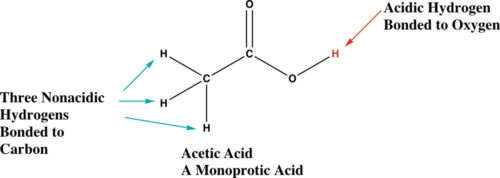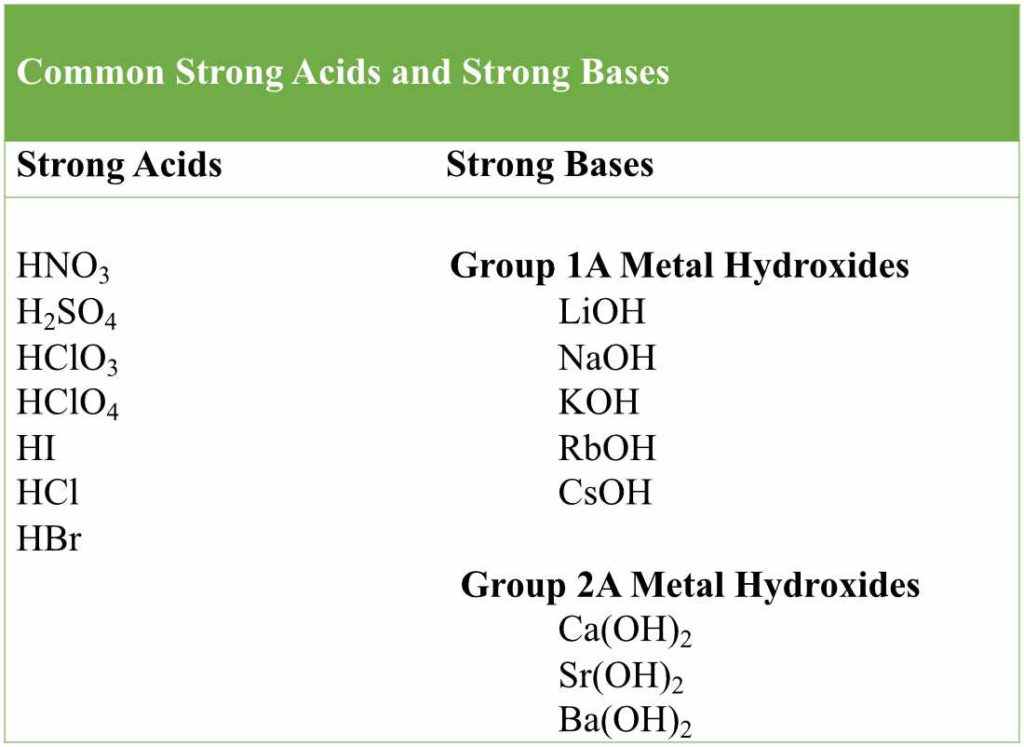Acids and Bases are important in many aspects of life. Many of them are used in industry and in households. In fact, many acids and bases are found in biological fluids. Hydrochloric acid is a component in the stomach that is important for digestion. Svante Arrhenius defined acids and bases back in 1887. According to the Arrhenius definition, an acid is a substance that dissociates in water to give hydrogen ions, H+ and a base is a substance that dissolves in water to give hydroxide ions, OH–.
In the equations above, HA represents an acid while MOH represents a metal hydroxide such as NaOH or KOH. The H+ ion is too reactive to be in water. A better representation is hydronium ion, H3O+. In aqueous solution, the hydrogen ion that dissociates from the acid will form a bond with a water molecule to produce the hydronium ion.
Both H+ and H3O+ are sometimes used interchangeably, but H3O+ is the species that results in an aqueous acid solution. We will write most of our equations in terms of the hydronium ion.
Strong acids essentially completely dissociate in aqueous solution. The strong acids are:
Know the names and formulas for the strong acids. Acids that are not on the strong acid list are weak acids in aqueous solution. H2SO4 is a strong acid while H2SO3 is a weak acid. Weak acids are weak electrolytes and only partially dissociate in aqueous solution. In fact, 0.10 M aqueous acetic acid, CH3
Please see the study guide on Nomenclature of Acids if you need to refresh your acid nomenclature.
Acids can have different numbers of acidic hydrogens. For example, HCl and HNO3 have one acidic hydrogen and are monatomic. H2SO4 has two acidic hydrogens and is a diprotic acid. Phosphoric acid, H3PO4 has 3 acidic hydrogens and is triprotic. Acetic acid, CH3COOH has 4 hydrogens, but is a weak monoprotic acid. Only the hydrogen that is bonded to the oxygen is acidic. We will find out why in a later study guide.
Like acids, there are strong and weak bases. Recall, the Arrhenius definition of a base is a substance that dissociates in water to produce hydroxide ions, OH–. Metal hyroxides containing Group 1A and some of Group 2A metals will dissociate completely when dissolved in water making them strong bases. For example, NaOH will completely dissociate in water to produce OH– ion and Na+ ion.
Sodium hydroxide is a strong base. The strong acids and strong bases are listed in the table below.
Notice, Mg(OH)2 is not included in the table. This is because it is not water soluble, but it does dissolve in acid. More about this in a later study guide. Notice, the strong bases are metal hydroxides.
One common base, NH3 is a weak base and a weak electrolyte. It only yields approximately 1% NH4+ and OH– ions. Note, NH3 does not have hydroxide in its formula, but when placed into water, it does yield hydroxide and ammonium ions, OH– and NH4+. Note the double arrows in the reaction below. They indicate a dynamic equilibrium between reactants and products. At equilibrium, the rates of the forward and the reverse reaction are equal. Weak acids and bases do not react (or dissociate) completely, therefore, we will include the double arrows with these equations. We will discuss equilibrium in a later study guide.
The Bronsted Lowry definition of an acid or base is more useful. A Bronsted Lowry acid is a proton donor, and a Bronsted Lowry base is a proton acceptor. A H+ ion is a proton. An acid donates a proton to a base; the base is the proton acceptor. A base must have a lone pair of electrons to form a bond with the hydrogen ion. This means that in our reaction below, the water is acting as an acid because it donates a proton to the weak base, NH3.
The curved blue arrows show electron movement. The arrow between the hydrogen and oxygen on the water molecule indicates when the bond breaks, the bonding electrons are left with the oxygen. The second arrow between the hydrogen atom and the lone pair of electrons on the ammonia, indicate the bond being formed between the lone pair of electrons on the ammonia molecule and the hydrogen ion to form ammonium ion. You will see more curved arrows in a later study guide as well as in organic chemistry.
Here, we look at HCl in water. Note we do not use a double arrow in the chemical equation because HCl is a strong acid with essentially 100% dissociation.
In the reaction, the H-Cl bond is broken, and the bonding electrons are left with Cl to form Cl– ion. The water molecule forms a bond with the hydrogen ion via the lone pair of electrons on oxygen. This is called a coordinate covalent bond because both electrons for the formation of the covalent bond come from one atom, in this case the oxygen atom.
We have been working with monoprotic acids. Let’s look at H2SO4, a diprotic strong acid. The first dissociation is complete but the second dissociation is incomplete. This is indicated by the double arrow.
Neutralization Reactions
A neutralization reaction is a reaction between an acid and a base in the appropriate stoichiometric quantities to produce a salt (ionic) and water.
One example would be the reaction between the strong acid HClO4 and the strong base NaOH. Aqueous sodium perchlorate (NaClO4) and water are formed.
The ionic equation is:
The net ionic equation is:
This is the net ionic equation for the reaction of any strong acid with any strong base. The net ionic equation can also be written in terms of H3O+ as:
A neutralization reaction also occurs between a weak acid and a strong base. The net ionic equation is different from that of a strong acid because the weak acid does not completely dissociate. For HCN:
The ionic equation is written as:
The net ionic equation is:
The weak acid only partially dissociates, therefore, the net ionic equation includes the neutral molecule (weak acid) and the anion of the weak acid.
Exercises
Exercise 1. Write a balanced ionic and net ionic equation when aqueous perchloric acid is neutralized by aqueous potassium hydroxide.
View Answer/Solution to Exercise 1
Exercise 2. Write a balanced net ionic equation for the neutralization of lithium hydroxide and hydrogen iodic acid.
View Answer/Solution to Exercise 2
Exercise 3. Write a balanced net ionic equation for the neutralization of HClO (perchlorous acid) and LiOH.
View Answer/Solution to Exercise 3
Exercise 4. Write a balanced net ionic equation for sulfuric acid (H2SO4) being neutralized by Ba(OH)2
View Answer/Solution to Exercise 4
Exercise 5. Oxalic acid (H2C2O4) is a diprotic acid. Write the 2 acid dissociation equations for aqueous oxalic acid.
View Answer/Solution to Exercise 5
Back to Reactions in Aqueous Solution
Back to Study Guides for General Chemistry 1
Back to Home Page





